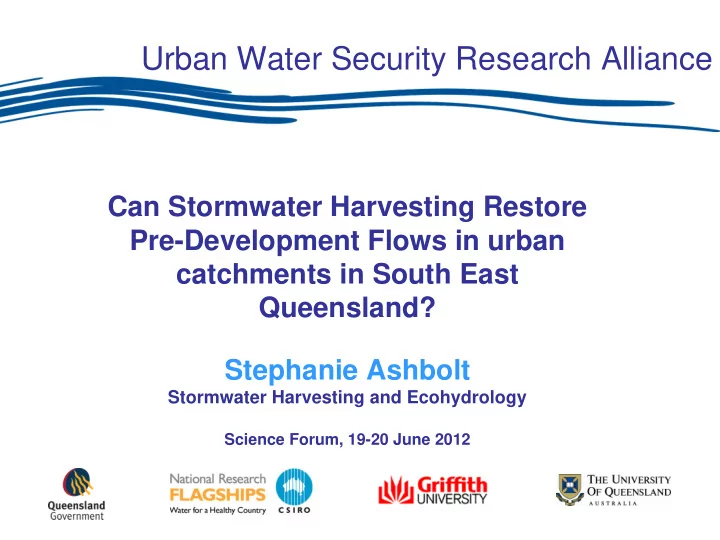

Urban Water Security Research Alliance Can Stormwater Harvesting Restore Pre-Development Flows in urban catchments in South East Queensland? Stephanie Ashbolt Stormwater Harvesting and Ecohydrology Science Forum, 19-20 June 2012
CONTENTS • Introduction – the problem • Aim of this work • Method – data, simulation modelling • Results – simulation analysis • Conclusions – how results relate to project aims
INTRODUCTION: THE PROBLEM Urbanisation or development of a catchment increases impervious surfaces, leading to: • Increased surface runoff • Reduced infiltration to groundwater Which means: • Increase in frequency, magnitude and duration of flow events • Increased erosion, changes to creek morphology
THE SOLUTION? Flow Frequency Management Objectives Designed to mitigate increase in frequency and magnitude of flow in urban developments. From the proposed development, capture and manage: – The first 10mm of runoff (per day) from impervious surfaces where the total impervious surface is 0 to 40% – The first 15mm of runoff (per day) from impervious surfaces where the total impervious surface is greater than 40% In other words, capture a volume equal to: – Impervious area (m 2 ) x target design runoff capture depth (mm/day) x 1000 Manage captured stormwater using one or more of: – Stormwater evaporation – Stormwater reuse (including rainwater collection and use) – Infiltration to native soils or a bioretention system – Flow diversion
AIM 1 Assess the effect of urbanisation on the flow regime 2 Assess the effect of Flow Frequency Management Objectives in restoring predevelopment flows, for a range of urbanisation extents Use calibrated and validated catchment models
DATA COLLECTION AND ESTIMATION • Rainfall: 0.2mm instantaneous tipping bucket rain gauge • Stream level: 6 minute pressure transducer • Rating curves: cross-section measurement, flow rate vs height (current meter, acoustic doppler current profiler), Hydstra software • Impervious area: automated analysis of aerial photos
UPPER YAUN CREEK Area: 362ha TIA: 3% ToC: 1.9 hours Slope: 6.8%
SCRUBBY CREEK Area: 144 ha TIA: 0% ToC: 1.1 hours Slope: 2.9%
TINGALPA CREEK Area: 2785 ha TIA: 1% ToC: 8.25 hours Slope: 0.9%
SIMULATION MODEL: SWMM Calibration: 18 months streamflow and rainfall data Hourly timestep Shuffled complex evolution algorithm (Matlab) Performance metric: Nash Suttcliffe Criterion of Efficiency
SIMULATION MODELLING SCENARIOS Various degrees of urbanisation: • Predevelopment (0% impervious) • Existing • 5, 10, 15, 20, 40, 50, 60, 70% impervious Above with runoff capture according to FFMOs capture volume = %IA*catchment area*10/15mm
RESULTS: YAUN CREEK URBANISATION Runoff at catchment outlet 0 % existing (3%) 1e+01 5 % 20 % 40 % 50 % 70 % 1e+00 Hourly runoff (m^3/s) 1e-01 1e-02 1e-03 0 5 10 15 Percent time hourly runoff is exceeded (%)
RESULTS: YAUN CREEK FLOW CAPTURE Runoff at catchment outlet 0 % 5 % 1e+01 5% with capture 20 % 20% with capture 40 % 40% with capture 1e+00 70 % 70% with capture Hourly runoff (m^3/s) 1e-01 1e-02 1e-03 0 5 10 15 Percent time hourly runoff is exceeded (%)
RESULTS YAUN CREEK 90 TH PERCENTILE FLOW 0.1 0.09 0.08 0.07 90th percentile hourly flow (m3/s) 0.06 0.05 0.04 0.03 0.02 0.01 0 0% impervious 5% impervious 5% impervious 20% 20% 40% 40% 50% 50% 70% 70% with runoff impervious impervious impervious impervious impervious impervious impervious impervious capture with runoff with runoff with runoff with runoff capture capture capture capture
RESULTS YAUN CREEK HIGH FLOW SPELLS 6 5 4 3 2 1 0 0% impervious 5% impervious 5% impervious 20% 20% 40% 40% 50% 50% 70% 70% with runoff impervious impervious impervious impervious impervious impervious impervious impervious capture with runoff with runoff with runoff with runoff capture capture capture capture High flow spell duration (% of record) Mean of high flow spell (m3/s)
RESULTS: SCRUBBY CREEK URBANISATION Runoff at catchment outlet 0 % 5 % 1e+01 20 % 40 % 50 % 70 % 1e+00 Hourly runoff (m^3/s) 1e-01 1e-02 1e-03 0 5 10 15 Percent time hourly runoff is exceeded (%)
RESULTS: SCRUBBY CREEK FLOW CAPTURE Runoff at catchment outlet 0 % 5 % 1e+01 5% with capture 20 % 20% with capture 40 % 40% with capture 1e+00 70 % 70% with capture Hourly runoff (m^3/s) 1e-01 1e-02 1e-03 0 5 10 15 Percent time hourly runoff is exceeded (%)
RESULTS SCRUBBY CREEK 90 TH PERCENTILE FLOW 0.002 0.0018 0.0016 90th percentile of hourly flow (m3/s) 0.0014 0.0012 0.001 0.0008 0.0006 0.0004 0.0002 0
RESULTS SCRUBBY CREEK HIGH FLOW SPELLS 5 4.5 4 3.5 3 2.5 2 1.5 1 0.5 0 High flow spell duration (% of record) Mean of high flow spell (m3/s)
RESULTS: TINGALPA CREEK URBANISATION Runoff at catchment outlet 10.00 5.00 0 % existing (1%) 5 % 20 % 40 % 1.00 50 % 70 % Hourly runoff (m^3/s) 0.50 0.10 0.05 0.01 0 10 20 30 40 50 60 Percent time hourly runoff is exceeded (%)
RESULTS TINGALPA CREEK FLOW CAPTURE Runoff at catchment outlet 10.00 5.00 0 % 5 % 5% with capture 20 % 20% with capture 1.00 40 % 40% with capture Hourly runoff (m^3/s) 0.50 70 % 70% with capture 0.10 0.05 0.01 0 10 20 30 40 Percent time hourly runoff is exceeded (%)
RESULTS: TINGALPA CREEK MEAN and 90 TH PERCENTILE FLOW 0.7 0.6 0.5 0.4 0.3 0.2 0.1 0 Average of mean hourly flow per day (m3/s) Top 90th percentile of daily flow (m3/s)
RESULTS TINGALPA CREEK HIGH FLOW SPELLS 10 9 8 7 6 5 4 3 2 1 0 High flow spell duration (% of record) Mean of high flow spell (m3/s)
CONCLUSIONS Generally: There is an increase in flow magnitude, frequency and duration with urbanisation. Flow capture according to FMMOs is able to reduce this impact towards a lower effective urbanisation. However: Flow frequency management objectives do not return to predevelopment for these catchments.
ACKNOWLEDGEMENTS Co-authors: Santosh Aryal Kevin Petrone Brian McIntosh Shiroma Maheepala With help from: Richard Gardiner Rezaul Chowdhury
Urban Water Security Research Alliance THANK YOU www.urbanwateralliance.org.au
Recommend
More recommend